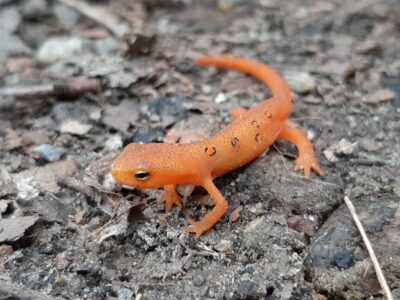Spring is the time for water. First the icicles start to drip. Then the streams and rivers begin to roar, carrying the snowmelt from upstream. The rock-hard frozen ground becomes a sponge underfoot, and your feet are always wet. Every dirt pile becomes a mud puddle, and muddy footprints fill the kitchen. Then comes a night of warm spring rain.
All this water must go somewhere. Some of the raindrops and snowmelt seep and trickle into shallow dips and hollows in the forest floor. Soon the leafy ground is dotted with clear, shallow pools, called vernal pools.
Vernal pools are a crucial part of the forest ecosystem. They might be the size (but not depth) of a swimming pool, but more often they’re smaller than a dining room table, or even a dinner plate. But even the tiniest vernal pool is a perfect nursery for amphibian babies. The pools provide the essential moisture that amphibian eggs need to develop. Twigs and leaves lining the bottoms of the pools provide lots of hiding spots for newly-hatched youngsters.
And vernal pools are ideal for forest amphibians for one big reason: no fish. Fish, even little sunfish, are the top dogs in aquatic environments like ponds, scooping up most of the eggs and young of frogs and salamanders. Fish-free ponds and pools are rich habitats for dozens of tiny species: snails, dragonflies, spotted turtles, fairy shrimp, American toads, and many species of salamanders.

The miniature frogs called spring peepers travel to these habitats to sing their jingling sleigh-bell song, seeking mates and laying eggs. Red-spotted newts journey overland to the pools, crawling on a slow-moving annual migration on legs that are half-an-inch long. Wood frogs, with a black mask like a raccoon over their face, make the trip, too. And spotted salamanders, each looking like a piece of enameled jewelry—shiny jet black with golden spots. All these creatures, and many more, depend on these small wetlands for breeding.
Vernal pools are ephemeral, as fleeting as trout lilies and anemones, hepaticas and trilliums--here for a few weeks in spring, vanished by summer. Sometimes the pools fill up again in a wet fall, or in a dry season they might just be a soft muddy spot. Because they’re generally wetter than the rest of the forest, they’re also mini-gardens for water-loving ferns and mosses.
Vernal pools are at risk, however. Their very existence is endangered because people don’t realize that they exist. It’s hard to protect something that isn’t there most of the time. When a road or a building site is proposed, no one bothers about a few muddy spots here or there. They’re scraped away by the bulldozer and no one knows they’re gone. No humans, that is. Frogs and salamanders often use the same pools for generation after generation, perhaps for decades or even centuries.
So when you ramble the spring trails at Landis, keep an eye out for those life-giving little pools. If we value the call of spring peepers, the night chorus of the toads and tree frogs, or the scarlet-orange flash of a young newt crossing the trail, we need to protect their habitat.
